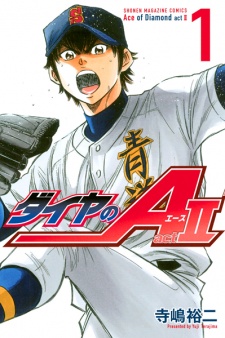*It's cruel how its strengths were the mangaka's own pitfalls*
~~
I just learned earlier that Terajima apparently didn't enjoy working with Daiya, especially Act II or the "Second-year Sawamura Arc" as he called it once. Why, that must have been a huge shocker to anyone who has seen and enjoyed his work that took more than a decade and a half of his life centering around the Seidou Baseball Club's measly one-and-a-half-year journey. A cruel fact to stumble upon that twisted my insides quite a bit for it shows one of the tragedies artists must brave, that no amount of glory received from your highly reputable
...
work could soothe the many afflictions you've experienced in reality, and how that very creation can be a primary source of the suffering of its creator. Such a potent whiplash knowing how the series does not see any effects of Terajima's depression, in truth it presents the opposite spectrum of emotions, while it veils whatever has been happening behind the scenes.
From what I've gathered, two main reasons led to the author viewing the franchise with disdain: one being the weekly publishing experience (enough has been said) and the plainness of Daiya Act I and Act II. For the sake of this writeup, we'll touch upon the latter.
As to why Terajima describes Act I as plain and Act II much plainer than its ancestor, it boils down to the expectations handed down to sports manga as a subset of the wide arrayed repertoire of fictional stories in a medium. It's been said that the story being very, very, very solely about baseball was the reason why drawing it felt like being in a rut to him. Ironically, that's the reason why I love Daiya so much, due to the consistency of hot-blooded matches and all things baseball--a sport that I knew nothing about prior to engaging in the series--and how it convinced me that it was a damn enjoyable sport. But I guess the operations betrayed the author, for that historical first Inajitsu match locked Terajima away from more freedom within the bounds of his story and out.
Due to Seidou's loss against a fiery, nigh unpredictable bout against Narumiya and his cronies, fans had the logical reaction of wanting for a rematch that will exceed the tip of Everest and shoot up beyond space that shall add to Daiya's list of legendary games. Terajima had to wrap up the third years' departure and build upon once more a rocky start. And what would that entail? More training, more practice, more matches, more baseball. But is that not to be expected? Won't that excite the people to witness Seidou slowly but surely overcoming the weaknesses that have been unearthed in order to finally reach the lofty heights barred by Inajitsu? I'd like to think it did, and the pace it went to flesh out the trying days between Act I and Act II before the presumed inevitable rematch in order to give respects to the finicky speed of progress in accordance with the unique disposition of each character whilst strengthening the interpersonal connection of ally and foe alike was a major part in my awe of Daiya.
But I guess that took a toll on an already exhausted mangaka. Perhaps the landmine explosion of limitation he didn't think of arriving on was demoralizing on top of the industrial pressure inherent on his work no matter the support system. Indeed the scope of its worldbuilding was very much little when compared to Mitsuda Takuya's Major, similarly a tale of baseball lads, who has escaped the clutches of Japan Nationals and a life expectancy of the three years of high school. Although little deviation is seen from the structural timeline and spatial field of Furudate's Haikyuu!!, it did start from the protagonist's juvenile aspirations and closes with a couple some chapters post-timeskip, and it ran with almost half of Daiya's overall chapter count and half of its whole runtime.
Additionally, one of its biggest strengths, the matches and the characters, became Terajima's personal pitfall, for he had to claw through his way to fashion up all of Seidou and the many antagonists representing every enemy team, all within the boundaries of baseball. There was little to no room for liberty of scenarios taking place outside the playing field or training grounds, travels to other places cannot allow leeway for frolicking about tourist spots, that is to say slice of life elements in Act II were decidedly unexplored for our shared conviction on strictly single-minded athletic developments.
Thus Daiya no Ace Act II ended up sailing through the uncharted future with a boilerplate formula, its captain scaping through to serve his constituents with familiar artistry obligatorily polished. I'd like to think a portion of Terajima's frustration is this limiting movement that resigns him to the main and only goal of the story, for Daiya lacks branches on its tree. I see it as its major asset which the mangaka gardened in exemplary manner, but alas adoration can't bend the truth.
All of that aside though, it's time for the review of the sequel itself.
Sawamura Eijun is a spectacular protagonist that is as dynamic as the height of excitement and as straightforwardly passionate as the manga. I believe he is one of the story's most prevailing strengths, thus worthy to note first and foremost. I acknowledge the solidness of his character, and the magnetic charm he possesses as a heart-on-sleeve hardworker bearing talent and the wisdom to open up his own potential. Huge entertainment value is scored by his demeanor and his wheel-of-fortune-based skillset. It's hype-inducing storywriting essential #1 to create a lead that has lot of things going for them. Take for example One Piece's Luffy and the increasing amounts of his fighting techniques, the versatility of Hinata from Haikyuu!!, or Cardcaptor Sakura's long list of Clow Cards for Sakura to choose from depending on the situation, such that clashes avoid dormancy. Eijun has his Numbers, the wildness of its potential masterfully exploited by Miyuki the catcher, making Eijun and him a very compatible pair. Daiya has no shortage of electric character connections. As mentioned before, it is a strong suit. The advent of a new set of first-years was a leverage for the future of the series, although I'd like to say that they weren't particularly of impactful substance to the memory of my senses.
To touch upon the technicalities of baseball more, I'm a complete novice but the strategies and actions were convincing and immersive to my ignorant brain. Terajima draws with such clean penwork of animated energy raw enough to feel the intensity of each match-up. Visual appeal earns gigantic points for its ease of readability through seamless choreography minimalistic and concise. You can feel the flow of motion as potential power is translated into a kinetic one, the severity of a home run and the speed of a pitcher's ball. You can picture out the direction of each throw, hear the sound of each strike on the catcher's glove; there is immense weight emanating out of the players' desire to win. These make Daiya no Ace an adept conveyer of its core as a train-and-match character-centric sports adventure which succeeds at one-upping itself every time.
As an ending note, allow me to express how surely I will miss this wonderful experience. I was actually not expecting to feel so emotionally invested on this story, such that rereading the results of the Inajitsu rematch a year and a half I finished it overwhelmed me with tears and awe still. I will miss the excitement every game brings, I will miss the quality set of antagonists in the form of Raichi, Narumiya, Sanada, and Amahisa. I will miss how each member of Seidou treats one another in an uplifting and affectionate way. I will miss how sorely into the character development journey I was, how shackled I became at the mercy of Terajima's whims every game. Most of all, I will miss Eijun, the antics and the glory of the ace.
Alternative TitlesSynonyms: Daiya no Ace act II Japanese: ダイヤのA〈エース〉 act II More titlesInformationType: Manga
Volumes: 34
Chapters: 309
Status: Finished
Published: Aug 19, 2015 to Oct 26, 2022
Genre:
Sports
Demographic:
Shounen
Serialization:
Shounen Magazine (Weekly) Authors:
Terajima, Yuuji (Story & Art) Statistics Ranked: #1172 2 based on the top manga page. Please note that 'R18+' titles are excluded. Popularity: #1111
Members: 18,167
Favorites: 1,070 Available AtResources | Reviews
Filtered Results: 5 / 5
Sort
Your Feelings Categories Jan 12, 2024
*It's cruel how its strengths were the mangaka's own pitfalls*
~~ I just learned earlier that Terajima apparently didn't enjoy working with Daiya, especially Act II or the "Second-year Sawamura Arc" as he called it once. Why, that must have been a huge shocker to anyone who has seen and enjoyed his work that took more than a decade and a half of his life centering around the Seidou Baseball Club's measly one-and-a-half-year journey. A cruel fact to stumble upon that twisted my insides quite a bit for it shows one of the tragedies artists must brave, that no amount of glory received from your highly reputable ... Feb 10, 2017
This Act II doesn't disappoint. In fact, it gets even better.
The adding of these new first years is very well done and you just can't wait to see them grow along the main characters. Bonus point as they add some fresh humor. Otherwise, Sawamura and Furuya are still fighting for the mound, but Sawamura is not the unreliable pitcher he was in his first year and is acknowledged by all at this point. He still messes up sometimes but that's just his character. What remains for him is obviously to get the Ace title, and he gets closer to it day by day. He keeps advancing ... Jan 6, 2017
Nobody had written a review yet so I decided to write one.
This is also my first review ever so if something is lacking or totally biased please understand. The story tells the continuation of Diamond no Ace. I recommend reading it first or finish both seasons of the anime. The story in Act II is not that different than in Act I, except for new grades and new characters. For me, the storytelling is stable and no sudden drop in hype. For the art, from the first time I read it until now, it's amazing. The readers can feel the intensity, the characters' feeling, and others just through ... May 2, 2017
I can't wait for the Season 3 though I know that maybe it will be published in 2018 or 2019.
I'm in love with all the characters especially Eijun Sawamura who is persevering in achieving his dream to become the Ace eventhough there is Saturo Furuya who is a monster. I love their friendly rivalry with the addition of the great captain Kazuya Miyuki and the batting prodigy Haruichi Kominato. I'm also looking forward to the addition of the new characters, the great freshmen. They are great. They add new depth to the anime. Eventhough the third years will not be able to play baseball after three ... Aug 3, 2017
i'm write this as some who know nothing about baseball when i started to watch ace of diamonds.since then i have learn a lot about baseball as well the character within the story.
the beauty of this manga is that you get to see the main character's evolve form there first year and the thing he learn long the way. because this manga has 4 main character it does jump around a little bit that being said this a a sports manga so you know what your getting into. why like this manga 1 the main character are fun to watch when interacting with other people. 2 reading how ... |

